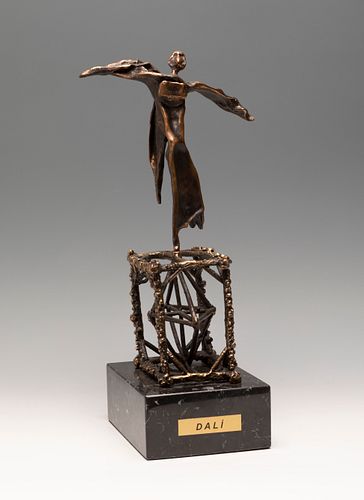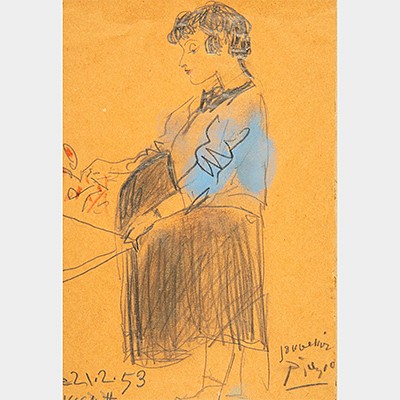SALVADOR DALÍ I DOMÈNECH (Figueres, Girona, 1904 - 1989). "Gala Gradiva", 1970. Bronze, copy 124/250. Signed. Enclosed publisher's certificate.
Lot 43
About Seller
Setdart Auction House
Carrer Aragó 346
Barcelona
Spain
Setdart Subastas was born in 2004 and is currently the first online art auction in Spain with solidity, prestige and reliability guaranteed by our more than 60,000 users. Setdart has a young, dynamic and enterprising team ready to successfully manage the purchase and sale of art works through custom...Read more
Categories
Estimate:
EUR€4,000 - EUR€4,500
$4,166.67 - $4,687.50
Absentee vs Live bid
Two ways to bid:
- Leave a max absentee bid and the platform will bid on your behalf up to your maximum bid during the live auction.
- Bid live during the auction and your bids will be submitted real-time to the auctioneer.
Bid Increments
| Price | Bid Increment |
|---|---|
| EUR€0 | EUR€10 |
| EUR€200 | EUR€25 |
| EUR€500 | EUR€50 |
| EUR€1,000 | EUR€100 |
| EUR€3,000 | EUR€200 |
| EUR€5,000 | EUR€500 |
| EUR€10,000 | EUR€1,000 |
| EUR€20,000 | EUR€2,000 |
| EUR€50,000 | EUR€5,000 |
About Auction
By Setdart Auction House
Sep 20, 2021
Set Reminder
2021-09-20 08:00:00
2021-09-20 08:00:00
America/New_York
Bidsquare
Bidsquare : CONTEMPORARY ART
https://www.bidsquare.com/auctions/setdart-auction-house/contemporary-art-7482
Setdart Auction House sofia@setdart.com
Setdart Auction House sofia@setdart.com
- Lot Description
SALVADOR DALÍ I DOMÈNECH (Figueres, Girona, 1904 - 1989). "Gala Gradiva", 1970. Bronze, copy 124/250. Signed. Enclosed publisher's certificate. Bibliography: Robert & Nicolas Descharnes, Dalí "Le dur at le mou, Sculptures & Objects", Paris, 2003, p. 170. Measurements: 34 x 11 x 7.5 cm (sculpture); 6 x 17 x 12 cm (base). For this sculpture, Salvador Dalí was inspired by Freud's reading of "Gradiva. A Pompeian Fantasy", a work by Wilhelm Jensen written in 1907 and translated into French in 1931. In Jensen's story, the young archaeologist Norbert Hanold becomes obsessed with Gradiva, a female figure he has seen in a classical relief. Dressed in a tunic, Gradiva appears to him on three occasions: at the time of the eruption of Vesuvius in Pompeii and when he visits the ruins of this ancient Italian city. Salvador Dalí, like the rest of the Surrealists, championed Gradiva as his heroine and personified her in Gala, his muse par excellence, christening her Gala-Gradiva. In this sculpture, Gala-Gradiva, who appears ethereal, slender and vaporous, seems to fly over a bridge in the shape of a clepsydra. It is a personification of Jensen's account of Freud, a sculpture charged with deep symbolism and emotional value for the surrealist genius. During his early years, Dalí discovered contemporary painting during a family visit to Cadaqués, where he met the family of Ramon Pichot, an artist who travelled regularly to Paris. Following Pichot's advice, Dalí began to study painting with Juan Núñez. In 1922, Dalí stayed at the famous Residencia de Estudiantes in Madrid to begin studying Fine Arts at the San Fernando Academy. However, before his final exams in 1926, he was expelled for claiming that there was no one there fit to examine him. That same year Dalí travelled to Paris for the first time. There he met Picasso, and established certain formal characteristics that would become distinctive of all his work from then on. His language absorbed the influences of many artistic styles, from classical academicism to the most groundbreaking avant-garde. At that time, the painter grew an eye-catching moustache in imitation of Velázquez's, which was to become his personal trademark for the rest of his life. In 1929, Dalí collaborated with Luis Buñuel in the making of "An Andalusian Dog", which depicted scenes typical of the surrealist imaginary. In August of the same year he met his muse and future wife Gala. During this period Dalí held regular exhibitions in both Barcelona and Paris, and joined the Surrealist group based in the Montparnasse district of Paris. His work greatly influenced the direction of Surrealism for the next two years, and he was hailed as the originator of the paranoiac-critical method, which was said to help access the subconscious by releasing creative artistic energies. In 1931 Dalí painted one of his most famous works, The Persistence of Memory, in which, according to some theories, he illustrated his rejection of time as a rigid or deterministic entity. The painter landed in America in 1934, thanks to the art dealer Julian Levy. As a result of his first solo exhibition in New York, his international reputation was definitively consolidated and from then on he showed his work and gave lectures all over the world. That same year he was subjected to a "surrealist trial" which resulted in his expulsion from the movement, on the grounds that the painter considered that Surrealism could exist in an apolitical context, refusing to commit himself to the ideas of André Breton. To this, Dalí responded with his famous retort, "I am Surrealism". Most of his work is housed in the Dalí Theatre-Museum in Figueras, followed by the collection of the Salvador Dalí Museum in St. Petersburg (Florida), the Reina Sofía in Madrid, the Salvador Dalí Gallery in Pacific Palisades (California), the Espace Dalí in Montmartre (Paris) and the Dalí Universe in London.
- Shipping Info
-
In-house shipping available. Please inquire at admin@setdart.com.
-
- Buyer's Premium



 EUR
EUR CAD
CAD AUD
AUD GBP
GBP MXN
MXN HKD
HKD CNY
CNY MYR
MYR SEK
SEK SGD
SGD CHF
CHF THB
THB
















